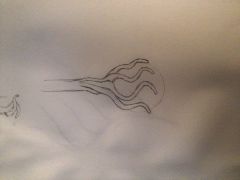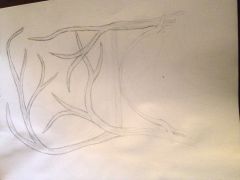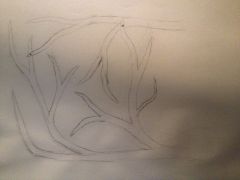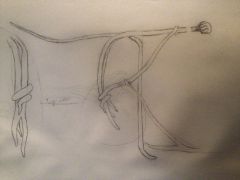-
Posts
63 -
Joined
-
Last visited
Content Type
Profiles
Forums
Articles
Gallery
Downloads
Events
Everything posted by Keganthewhale
-
I have a two fishers, one is from 1904 but it's only about #130 (we guess, we haven't weighed it yet), and a #150 from 1944. The older one was badly abused and we are trying to restore it a best we can, but regardless, they are both wonderful (and quiet!) anvils that my wife and I thoroughly enjoy working on. Where are you located? (If you don't mind me asking)
-
The eagle is gone? But it still says 'fisher' on the foot? I would very much like to see some pics if you have any, it sounds interesting.
-
And what is the diameter of the part missing? Because to be honest, if you are only interested in the functionality of the anvil you could make a hardy-horn that has the diameter of the missing piece. And it could have a a finer tip than the normal horn would be.
-
How much of it is broken off? Like an inch? Or 3 inches? How heavy is it?
-
So when you have an idea and you sketch it out, what is your process from there? Do you sketch, then sketch again to give it some sort of scale and dimension? Do you make a miniature before goin full size? If you do a miniature what materials do you use so it's easily manipulated if you don't like how it looks in 3d? I'm just curious about the processes of people who are wiser than myself, it'd be a shame to have an idea, and waste time and material, and money on something that doesn't come out how you see it in your head.
-
So I managed to pick up 20' or more of 1.5 in round bars, somewhere off of a railroad track or something. I have no idea what kind of steel they might be, but considering they were used for railroad tracks it's probably not terribly soft (and I promise I will get around to drawing it out and quenching then breaking it to see the grain at some point, just not yet). Anyway, assuming it's not mild steel, what kind of tools would everyone make if they had the bar, and why. I know I want to do a straight pein and diagonal pien hammer at some point, and it would be perfect for hardies, but what hardies would the wiser recommend? -Kegan
-
thanks Jim, i appreciate the forthright answer =] i probably wont be attempting it that being the case.
-
is there a reasonably fast way to cut railroad track without using an angle grinder or bandsaw? i highly doubt taking a chisel on the perimeter until it has a line all the way around, then placing a rock or something on one side of the line sledging the other side would cause it to break, but thats all my tiny brain can come up with at the moment. any thoughts or suggestions are appreciated! -kegan
-
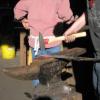
Blacksmithing gems and pearls
Keganthewhale replied to Glenn's topic in Blacksmithing, General Discussion
"If Daniel Boon would've had it he'd have used it!" my first blacksmith teacher John (grape day park) -

If I were to cast an anvil.
Keganthewhale replied to Keganthewhale's topic in Smelting, Melting, Foundry, and Casting
i already have a 150# fisher, that i love dearly! however! i was merely curious if it were possible to make your own anvil. -

If I were to cast an anvil.
Keganthewhale replied to Keganthewhale's topic in Smelting, Melting, Foundry, and Casting
The steel I have access to is not the most workable shape, but could readily used for hammer heads or mini anvils, or a swage or hardie. Thankyou everyone for your input, I do appreciate it! I'd like to remind everyone that I did say, "And remember it's more of a mad mans curiosity than a plan..." I definitely don't have the means or experience or a plan to do any of it, but I appreciate everyone entertaining my dumb questions. -
So I found a place to get some really nice tool steel and lots of it for free, and although it would be years before I would be in a place to cast my own anvil I had some questions that I'm hoping all you kind folks could help me with. I've casted bronze in the past using the lost wax method but was curious about other methods. Can you cast into plain pottery clay and it not be dangerous? If so would it cause the product to come out looking horrendous? Could you cast it in multiple steps, ex: horn and face in one pour, body in another or several other pours? Any thoughts on this would be greatly appreciated! And remember it's more of a mad mans curiosity than a plan (at this point anyway!)
-
So I bought a 150# fisher anvil Sunday, and I love it! but I was measuring and admiring it and I noticed the hardie hole being a tiny bit small. It's about 1/16th of an inch too small one way and 1/8th inch small the other direction, and I was wondering if anyone thinks its worth trying to modify the anvil, or just make my hardies fit the anvil? my only concern with doing that is when I eventually get another anvil and the hardies are too small. thoughts everyone?
-

help with wrapping joinery on chairs.
Keganthewhale replied to Keganthewhale's topic in Problem Solving
i really want to do that, but i think i want to make a couple versions of it miniature, like 1/3 the size so i have a display that could be modified so that if anyone wants one it could be made to whatever height or minor tweaks that person might desire. but i would have to agree that i need to get a torch! -

help with wrapping joinery on chairs.
Keganthewhale replied to Keganthewhale's topic in Problem Solving
So i'm finally in a place where i can upload pics! so the first image (if i'm not mistaken) is a side view of the chair and then there are two versions of the back of the chair and then there is one of what i would like the foot of the chair to roll to some extent on that ball. but the on the side view you can see where its similar to a vine but it wraps on both the arm rest and the leg of the chair, but if i wrap one side i dont know how i would heat the other end to wrap without having a torch to localize the heat. i could go to the metal shop on base, but i try to avoid being on base any longer than i need to be. so any other advice would be appreciated, if i do have to wait to get a torch then i guess that it what i will have to do. but i just wanted to share what i said i would and maybe get some feedback on it. -Kegan http://www.iforgeiron.com/gallery/image/37809-chair-side-image/ http://www.iforgeiron.com/gallery/image/37810-chair-back-v2/ http://www.iforgeiron.com/gallery/image/37811-chair-back-v1/ http://www.iforgeiron.com/gallery/image/37812-chair-foot-image/ -
i've never forged a chalice, but i did cast three at one point. they turned out way heavier than i expected (bronze), but if you're dead set on forging them then i have no experience to speak from. i would like to see the results if you get one made though!
-
my final result, if i can find a way to get it to work without rusting the whole thing then removing what i don't want there, is to essentially draw a picture whether it be with wax or oil or something then let everything else rust and blue, basically leaving you a negative blued picture on a steel plate. but i'm more interested in the process than the end result, because i absolutely could rust blue the whole thing and go back with a dremel and remove the blue i don't want. does that make sense? because sometimes i think my ideas are crazy because i've never seen them done before.
-

help with wrapping joinery on chairs.
Keganthewhale replied to Keganthewhale's topic in Problem Solving
i am indeed stationed at lejeune, however i'm not in country at the moment (hence not being able to post pictures due to internet rules) and i suppose once i've got it mostly built and am at the point to do the second wrap i could try the auto hobby shop to see if i could use their torch, but for the time being i can't afford a torch setup, and i'm hoping that once i'm out i will be able to afford one. but there is no other way to get both wraps without outsourcing to some extent? -
so from what i've gathered to rust blue something you must clean the surface from any coatings, oiled, other finishes, then you must allow it to rust a deep red, thick and thoroughly, then you must 'boil' it in distilled water and then essentially rub/polish it down with a cloth until it turns a blackish color. now if there is more to it than that i am all ears! (i figure it wont be terribly easy to do, but those are the steps i've come to understand) now my question here is this, i want to blue a certain part of mild steel but not another section of the same piece. so lets say we have a 6"x6"x1/4" piece of mild steel that has had its surface cleaned by heating it to a cherry red and hit with a degreased wire wheel until cool, then cleaned with acetone. how can i get a 1" stripe of blue down the center yet keep either side essentially polished or at least rust/blue free?
-
so i have a design for a chair that deals with branch-like-vines and wrapping, i would post pics of the drawings but i can't currently due to very restricted internet at the moment. Regardless of that, the legs runs up into both the armrest and the back support, the support from the middle of the armrest runs down to the middle of leg, but i want that support to be wrapped around both the arm rest and leg. i'm hoping that is descriptive enough to get the real problem figured out though! here it is: using a gas forge (metalsmithing from diamondback ironworks) how can you wrap one side to the arm rest (which is built into the legs mind you) back down to the leg? the back of the chair is running off of the same piece as the leg, so you can't really stick the other end back into the forge to get to wrap it around, and i don't have a torch to heat it up to wrap it around the leg. i really hope all of this make sense! if not i will post pictures of my sketches once i'm in a place that can allow me to put pictures up.

